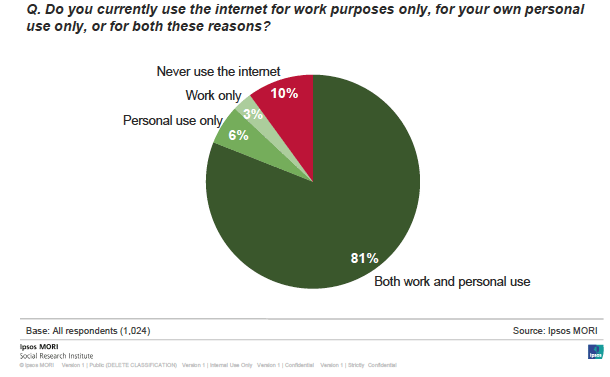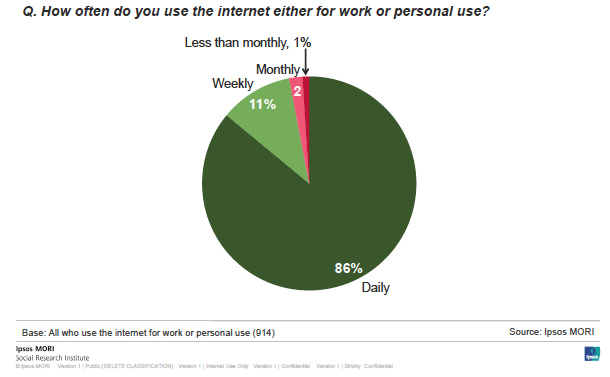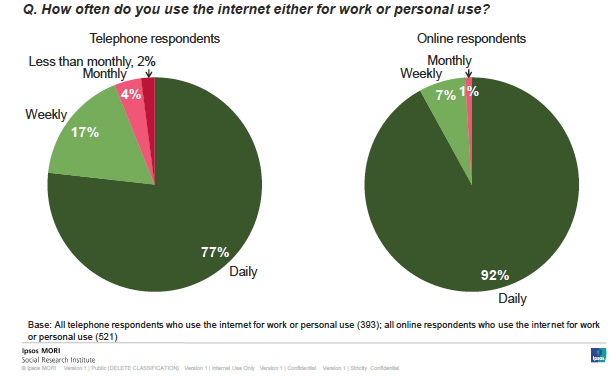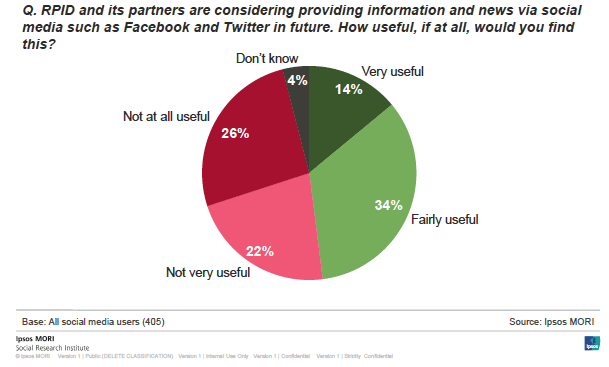RPID Customer Satisfaction Survey to Inform the Futures Programme
The Scottish Government’s Rural Payments and Inspections Division (RPID) commissioned Ipsos MORI Scotland to measure customer satisfaction with the services of the division and its partner organisations Forestry Commission Scotland and Scottish Natural Heritage.
5 Online Behaviours
Summary
1. The majority of respondents from both parts of the sample have broadband access, and use the internet on a daily or weekly basis, and use it for work purposes.
2. A test of internet download and upload speeds in the online survey found little difference in speeds amongst the sample group, across Scotland.
5.1 The final part of the survey looked at aspects of the online behaviour of those respondents who use the internet for work or personal use. As shown in figure 5.1 below, four-fifths of respondents said that they use the internet for both work and personal use, with 6% saying that they do so for personal use only and 3% saying that they only use the internet for work. One in ten said that they never use the internet.
Figure 5.1: Purpose of internet use

5.2 Telephone respondents were more likely than online respondents to say that they only use the internet for personal use (8% compared with 4%), while online respondents were more likely than telephone respondents to report using the internet for both work and personal use (94% compared with 68%). A comparison of all respondents' internet usage with that of respondents to both modes of the survey is shown in table 5.1 below.
Table 5.1: Purpose of internet use
| All | Telephone | Online | |
|---|---|---|---|
| Work and personal use | 81% | 68% | 94% |
| Personal use only | 6% | 8% | 4% |
| Work use only | 3% | 4% | 2% |
| Never use the internet | 10% | 21% | - |
| Base | 1,024 | 502 | 522 |
5.3 The majority (86% overall) reported using the internet daily, and 11% weekly, as can be seen in figure 5.2 below.
Figure 5.2: Frequency of internet use

5.4 As can be seen in figure 5.3 below, over 90% of respondents from both samples use the internet for either work or personal use (n=393 telephone respondents and 521 online) on at least a weekly basis.
Figure 5.3: Frequency of internet use

5.5 Agents (96%), other rural businesses (95%), respondents in the Highland region (96%) and online SAF applicants (92%) were more likely than overall to report using the internet on a daily basis, while respondents in the Southern region (22%), paper SAF applicants (20%), and farmers (14%) were more likely than overall to say they did so weekly. Frequency of internet use across the whole sample and both survey modes is shown in table 5.2 below.
Table 5.2: Frequency of internet use
| All | Telephone | Online | |
|---|---|---|---|
| Daily | 86% | 76% | 92% |
| Weekly | 11% | 17% | 7% |
| Monthly | 2% | 4% | 1% |
| Less than monthly | 1% | 2% | * |
| Base | 914 | 393 | 521 |
5.6 In terms of the types of internet connection used by respondents, 97% said that they used a broadband connection, compared with 3% who use a dial-up connection. In addition, 19% have 3G mobile access.
5.7 Of those respondents who use the internet at work, 65% reported using a desktop PC, 54% said that they use a laptop, 22% used a Smartphone, and 15% mentioned using a tablet device. Only a small number of respondents reported using the internet for personal use only. Taking all internet users together, device usage overall is similar to that of those who use the internet at work, as shown in table 5.3 below.
Table 5.3: Devices used to access the internet
| Work | Personal | Work or personal | |
|---|---|---|---|
| Desktop computer/PC | 65% | 45% | 64% |
| Laptop | 54% | 66% | 55% |
| Smartphone | 22% | 12% | 21% |
| Tablet | 15% | 8% | 14% |
| Base | 850 | 64 | 914 |
5.8 Online respondents were more likely than telephone respondents to report using a laptop (67% compared with 59%), Smartphone (27% compared with 13%) or tablet device (17% compared with 10%).
5.9 Respondents were then asked which browsers they mainly use to access the internet. Fifty-four per cent reported using Internet Explorer, with 41% using Google Chrome, 17% using Mozilla Firefox and 11% using Safari.
5.10 Respondents from other rural businesses (65%) were more likely than overall to use Internet Explorer, while agents (27%) and respondents in the Central region (22%) were more likely to use Mozilla Firefox.
5.11 Telephone respondents were more likely than online respondents to use Google Chrome (45% compared with 37%), while the reverse was true of Internet Explorer (60% compared with 45%), Mozilla Firefox (20% compared with 13%) and Safari (16% compared with 4%).
5.12 Respondents were asked about the frequency with which they engaged in various online behaviours. Overall results are in table 5.4 below. Forty-three per cent of respondents said that they looked for information on comparing products or suppliers on a weekly basis, with a further 13% doing so daily and 25% monthly. Those in the Southern region (39%) and agents (38%) were more likely than overall to report doing this on a monthly basis.
Table 5.4: Frequency of online behaviours
| Daily | Weekly | Monthly | Less than monthly | Never | |
|---|---|---|---|---|---|
| To go on social media websites such as Facebook and Twitter | 20% | 13% | 3% | 7% | 56% |
| To do your banking online | 16% | 39% | 12% | 4% | 29% |
| To look for information on comparing products and suppliers | 13% | 43% | 26% | 13% | 4% |
| To buy things online | 5% | 35% | 34% | 18% | 8% |
| To look for online information provided by government, council or NHS | 4% | 21% | 35% | 29% | 11% |
| To use an online service provided by government, council or NHS | 2% | 13% | 42% | 35% | 8% |
5.13 Just over one-third of respondents said that they bought things online weekly (35%) or monthly (34%), while 18% said that they do so less frequently than monthly. Only 5% said that they do this on a daily basis. Other rural businesses (44%) were more likely than overall to report that they do this monthly. Those in the Southern and Central regions (27% and 23% respectively) were more likely to buy things online less than monthly, than overall.
5.14 Just over one-third of respondents said that they look online for information provided by government, the council or the NHS on a monthly basis, with 21% doing so weekly and 29% less than monthly. Other rural businesses (41%), agents (39%) and those in the South Eastern region (31%) are more likely than overall to look for such information on a weekly basis. Indeed, agents (16%) and other rural businesses (10%) are more likely to do this on a daily basis than overall (4%), while crofters (35%) are more likely than overall to do so less than monthly.
5.15 Two-fifths (42%) of respondents said that they use online services provided by government, council or NHS (such as VAT submission or tax returns) on a monthly basis; 35% said that they do so less than monthly, and a further 13% do this weekly. Crofters (50%) were more likely than overall to do this less than monthly, while farmers (47%) were more likely than overall to use such services monthly. Other rural businesses (20%) were more likely than overall to do this on a weekly basis.
5.16 Thirty-nine per cent of respondents said that they did banking online on a weekly basis, with 16% daily and 12% monthly. Young farmers (56%), those in the 25-40 age group (55%) and those in the Highland region (49%) were more likely than overall to do online banking weekly.
5.17 The data seem to suggest that there is a shared set of characteristics among those respondents who do not use these online services. Twenty-nine per cent of respondents said that they never use online banking; 45% of paper SAF applicants, 34% in the 65-and-over age group, and 32% of farmers do not do their banking online.
5.18 Eleven per cent of respondents say that they do not look online for information provided by government or public bodies; 21% of those who submitted a paper SAF, 19% of the 65-and-over age group and 13% of farmers also fall into this category. Similarly, 8% of all respondents do not use government or public body-provided online services; this proportion increases to 14% of: paper SAF applicants; respondents in the 65-and-over age group; and crofters.
5.19 Eight per cent of respondents said that they do not buy things online; 16% of paper SAF applicants, 13% of the 65-and-over age group and 10% of farmers were more likely than overall to say that they never do this.
5.20 One in five respondents said that they use social media on a daily basis (n=405), with a further 13% doing so weekly; however, 56% said that they do not use social media. Those aged 25-40 (34%), young farmers (32%), women (27%), online respondents (24%) and online SAF applicants (23%) were more likely than overall to report using social media daily. It is possible that there is a degree of overlap between respondents in these subgroups. Respondents in the 65+ and 41-64 age groups (75% and 55% respectively), telephone respondents (62%), farmers (62%) and men (59%) were more likely than overall to say that they never use social media, as were those in the Southern and South Eastern regions (70% and 66% respectively).
5.21 Respondents who use social media were asked how useful it would be if RPID were to provide information and news via sites such as Facebook and Twitter in the future, with opinion divided as to whether or not this would be useful. Overall results are shown in figure 5.4 below. Agents (68%) were more likely than overall to think that such a service would not be useful, while farmers over the age of 40 and those satisfied with RPID were more likely than overall to say that it would be useful (both 53%).
Figure 5.4: Usefulness of provision of news and information via social media

5.22 Finally, respondents of the online survey were asked to complete a speed test in order to measure both the download and upload speeds of their internet connection. The purpose of this was to determine if there was a relationship between geographical location and connection speed. It was thought that slow connection speeds may have been a barrier to the use of RPID and its partners' online services; however, these results would seem to indicate otherwise.
5.23 Respondents were given a link to a speed test site, and upload and download speeds were tested. Respondents were then able to record the respective speeds in either mb/s or kb/s. Only small numbers recorded speeds in kb/s, so results for those who reported in mb/s are presented by region in tables 5.5 and 5.6 below.
Table 5.5: Download speeds by region (mb/s)
| Download speed (mb/s) | Overall | Argyll & Western Isles | Central | Grampian | Highland | Northern & Northern Isles | South Eastern | South Western | Southern |
|---|---|---|---|---|---|---|---|---|---|
| <1.0 | 17% | 31% | 16% | 6% | 17% | 16% | 17% | 19% | - |
| 1.0-2.99 | 32% | 25% | 42% | 27% | 25% | 32% | 22% | 41% | 35% |
| 3.0-4.99 | 16% | 9% | 8% | 34% | 11% | 11% | 25% | 12% | 27% |
| 5.0-9.99 | 24% | 26% | 21% | 17% | 33% | 31% | 21% | 17% | 26% |
| >10.0 | 12% | 11% | 6% | 14% | 11% | 13% | 5% | 12% | 12% |
| Not stated | 1% | 2% | 2% | 2% | 2% | - | - | - | - |
| Base | 417 | 54 | 104 | 64 | 35 | 56 | 60 | 26 | 18 |
Table 5.6: Upload speeds by region (mb/s)
| Download speed (mb/s) | Overall | Argyll & Western Isles | Central | Grampian | Highland | Northern & Northern Isles | South Eastern | South Western | Southern |
|---|---|---|---|---|---|---|---|---|---|
| <1.0 | 83% | 80% | 83% | 83% | 82% | 87% | 81% | 84% | 94% |
| 1.0-2.99 | 8% | 15% | 6% | 9% | 8% | 4% | 8% | 8% | 6% |
| 3.0-4.99 | 1% | - | 1% | - | 3% | 1% | - | - | - |
| 5.0-9.99 | 2% | 3% | 1% | 3% | - | 1% | 2% | 4% | - |
| >10.0 | 5% | 2% | 7% | 3% | 7% | 9% | 7% | 4% | - |
| Not stated | 1% | 2% | 2% | 2% | - | - | 2% | - | - |
| Base | 415 | 54 | 104 | 64 | 35 | 54 | 60 | 26 | 18 |
5.24 In terms of download speeds, there was found to be little in the way of significant differences in regional variation, with the main points of difference being a higher than overall likelihood of 0-0.9mb/s in Argyll & Western Isles (31% versus 17%); higher than overall likelihood of 1.0-2.99mb/s in Central (42% versus 32%); and higher than overall measure of 3.0-4.99mb/s in Grampian (34%) and South Eastern (25% versus 16% overall).
5.25 Moreover, crofts (22%) and farms (19%) were more likely than agents (5%) to report download speeds of 0-0.9mb/s, while farms were also more likely than agents to report download speeds of 1.0-2.99mb/s (36% versus 18%).
5.26 No statistically significant regional variations were found in terms of upload speeds, with at least four-fifths nationally and in each region reporting speeds of 0-0.9mb/s. Again, the most significant differences were found between business type. Farmers (89%) and crofters (80%) were more likely than agents (63%) to report upload speeds of 0-0.9mb/s; while agents (8%) were more likely than other rural businesses (2%) and farmers (<1%) to report upload speeds of 10.0-19.9mb/s.
Key points
5.27 Ninety per cent of RPID customers surveyed are online, with 84% overall (72% of telephone respondents and 96% of online respondents) reporting that they use the internet for work purposes.
5.28 The majority of respondents have internet access via broadband, only a small percentage using dial-up, and a fifth have 3G mobile access. Broadband speeds tested in the online survey were found to be broadly similar across the country.
5.29 Only 6% of those who had submitted a paper SAF cited a too-slow internet connection as a barrier to using the online SAF system, with little in the way of regional variation. This would appear to suggest, then, that internet speed in itself is not a major barrier to customers' use of online services, and that the personal preferences of a significant minority of people is the major factor which must be considered.
Contact
Email: Angela Morgan
There is a problem
Thanks for your feedback